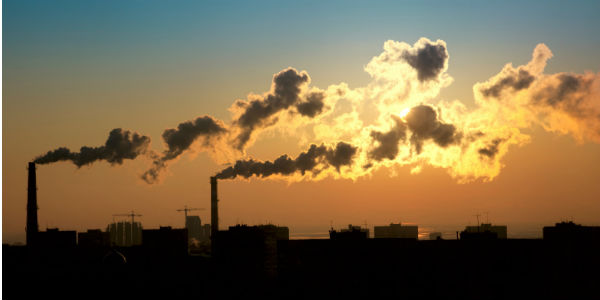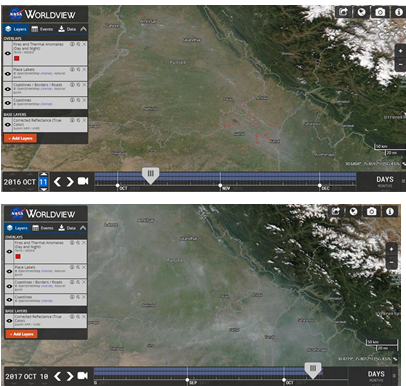 Half of October has gone and a heady mix of biomass burning, fly-ash and unhealthy spikes in air pollution has already replaced the signature October weather consisting of balmy skies and falling temperature.
Half of October has gone and a heady mix of biomass burning, fly-ash and unhealthy spikes in air pollution has already replaced the signature October weather consisting of balmy skies and falling temperature.
The burning of agricultural residues, also known as stubble burning, has resulted in deterioration of Delhi’s air quality. The worst part - Air quality in Delhi is set to worsen.
In desperation for cleaner air, National Green Tribunal (NGT) imposed a ban on stubble burning in Haryana, Punjab, Delhi, Uttar Pradesh and Rajasthan in December 2015. Unfortunately, the implementation of the ban still remains tardy in agrarian states of India.
Repeated orders or directions from NGT to governments of Haryana, Punjab and three other states on creating awareness among farmers on the adverse effect of burning of crop residues and incentivizing to stop the practice have fallen on deaf ears.
[yuzo_related]
Industry reports suggest that nearly 20 million tonnes of straw in the fields are still being burnt, clearly indicating the failed efforts of state governments.
Stubble burning likely to continue this year
Despite the ban imposed by NGT, stubble burning in Punjab and Haryana is likely to continue this year as both the states are expecting to witness a bumper paddy crop this Kharif season. The farmers are expecting paddy crop in excess of 22 million tonnes. As a result, the crop residue that will be burnt is slated to be phenomenal.
The Science and Technology Department in Punjab has suggested alternative measures like straw management equipment and crop diversification in order to manage some of the paddy residue. The steps, however, require significant investment. The state has also launched various campaigns to create awareness among the farmers about the ill-effects of stubble burning.
Yet agitated farmers from Punjab assembled outside NGT’s premises in New Delhi on October 4, 2017. They blamed NGT of being unaware of the ground situation and blamed their state government for not providing adequate financial assistance in lieu of desisting from crop burning.
The situation is similarly miserable in the neighbouring Haryana, where campaigns are being run on generating awareness among the people against crop burning, however, nothing seems to be coming out it.
Farmers forced to undertake stubble burning
If we compare this year’s NASA images (National Aeronautics and Space Agency) of farm fires to last year’s, we might be surprised by the reduction in a number of detectable incidents. While last year, areas around Patiala, Ambala, Karnal and Kaithal exhibited large numbers of red spots depicting stubble burning in those areas, they appear to be clean of any burning spots this year.

However, we will be mistaken to believe these images at face value.
One of the many reasons for this reduction in the incident could be attributed to delayed harvest this year as compared to last year which is normally few days on either side of Diwali. Burning usually takes place after several days of actual harvest as the focus of farmers is generally on selling grains after harvesting.
Farmers are forced to burn the paddy stubble in the short window of 15-20 days available between the harvesting of paddy and the sowing of the next wheat crop. The vicious cycle consists of harvesting and marketing the Kharif crop and sowing the next Rabi crop. Burning, hence, seems to be the easier option to prepare fields for next yield.
Even though farmers are aware of the environmental fall-out and ill effects of burning paddy on a mass scale, lack of monetary help at their disposal is the biggest reason behind resorting to stubble burning.
In absence of any long-term solution and financial support, farmers in Punjab and Haryana have begun to burn paddy straw in their fields, turning defiant to NGT’s order on stubble burning ban.
Disparity between NGT’s Directive and Government’s action plan
The intensive crackdown on stubble burning started when in September 2014, a petition filed by environmentalist Vikrant Tongad led NGT to issue strict directions to Centre and 5 states against straw burning.
The ban was imposed in 2015 and NGT laid out a clear roadmap for the states to provide alternatives to farmers in curbing and eventually stopping the practice of stubble farming due to its ill effect on air quality.
Despite the orders, the capital continued to suffer the effects of air pollution caused by stubble burning and crackers and unfortunately suffered from one of the major air quality crises of the decade after Diwali.
The Air Quality Index (AQI) fell under 'severe' category, thereafter the AQI (PM2.5 and PM10) breached the 500 mark at all locations in Delhi.
The green court’s orders are still far from implementation as just two months back NGT castigated the state governments for their inaction on a plan for stubble burning.
A bench comprising NGT chairperson justice Swatanter Kumar warned governments in August 2017 and asked them to furnish an action plan within a week. Till date, no action plan has been provided.
The situation is still dismal as just last week farm leaders from Bharatiya Kisan Union (Rajewal) told the NGT that the agriculture department had barely provided incentives and machinery to them for disposing off paddy straw. "We do not want to burn the paddy straw, but it is a financial burden to use anything other than burning. We have a very short time window to dispose off the paddy straw between the harvest and next round of sowing. The small and marginal farmer cannot afford to pay Rs.6,000 or more per acre for managing the farm stubble," Onkar Singh Agaul, General Secretary, BKU(Rajewal) told DNA.
On the other hand, in their defense, governments are blaming the Centre for an inadequate supply of machinery and meaningful solutions.
According to Business Standard, Punjab’s Chief Minister Amarinder Singh has stated that the state government would not pressurise the farmers in the process of implementing the ban on burning of paddy residue. There is no question of penalising the farmers.
While NGT and government take time to resolve the matter, farmers are left with no choice but to burn the crop residues. Delhi and other neighbouring cities continue to choke while residents keep demanding clean air.
Image credit: Indian Express
Any information taken from here should be credited to skymetweather.com


